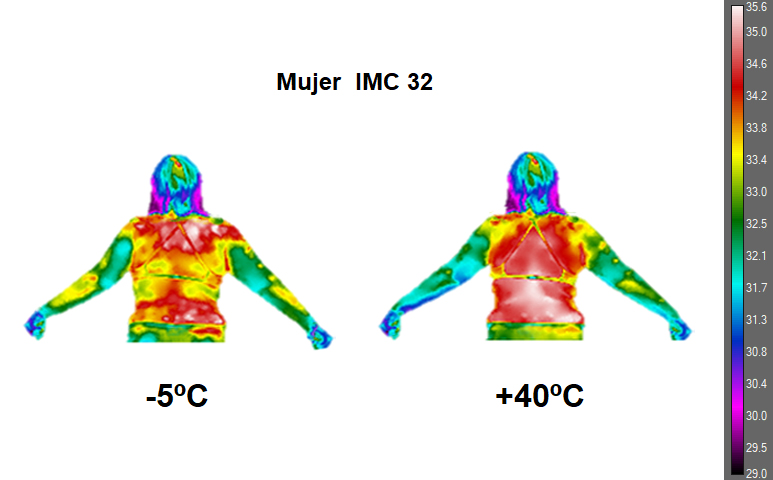
The IBV, ASCIRES, INCLIVA and SABARTECH are joining forces to develop a methodology for the comprehensive assessment of obesity
The increase in obesity in society is so worrying that the World Health Organisation (WHO) has classified it as a pandemic. Obesity is a chronic and complex disease characterised by excess body fat, which increases the risk of serious health complications and has many associated pathologies, including cardiovascular disease, type 2 diabetes, potential sarcopenia or certain types of cancer, including breast, colon, endometrial and oesophageal, among many others. Obesity also affects a person’s mental health and quality of life, as those affected often experience stigmatisation and discrimination, which can lead to problems with self-esteem, anxiety and depression.
It also poses a major challenge to the healthcare system due to its increasing prevalence and the high costs involved in treating associated and secondary diseases.
The complex pathophysiology of obesity and its association with complications affecting several body systems calls for a comprehensive and multidisciplinary approach, including a thorough assessment of the patient’s condition, taking into account, on an individual basis, specific body composition and distribution, metabolic risk and associated complications, and functional limitations. Although these aspects can be assessed separately by existing methods, they have limitations that prevent their integration into healthcare processes, such as their subjectivity and observer-dependence (as in the case of skinfold measurement to assess subcutaneous fat), or their complexity, cost and invasiveness (as in the case of dual-energy X-ray absorptiometry (DXA) to assess the percentage of total body fat and its distribution, or magnetic resonance imaging (MRI) to determine the amount of visceral adipose tissue).
In this context, the Instituto de Biomecánica (IBV), ASCIRES, the Instituto de Investigación Sanitaria INCLIVA and SABARTECH have joined forces to develop an advanced methodology for the comprehensive and personalised morpho-functional assessment of patients suffering from obesity. The 28-month project, called FITME, is coordinated by the IBV and is supported by the Agencia Valenciana de la Innovación (AVI) (IVACE+i Innovación) of the Autonomous Government of Valencia and co-funded by the European Union.
The specific objective of FITME is to develop a multiscale model that, by combining morphofunctional and omic variables, is able to estimate body composition and distribution and metabolic risk in a personalised and accurate manner.
To this end, an objective, versatile, sustainable, non-invasive and expert-independent methodology will be developed to provide a comprehensive assessment of the obese patient, designed to be integrated into the healthcare context and overcome current limitations.
Innovative technologies for obesity assessment
This research will include the use of IBV human form analysis technologies such as MOVE4D or 3D Avatar Body, markerless instrumental biomechanical analysis and thermographic techniques, all of which are non-invasive and do not expose patients to ionising radiation as is the case with some of the techniques currently used. In addition, omic techniques will be used, in particular a novel genetic analysis technique based on AIG (Automated Intelligence Genetics), which will be developed by SABARTECH for the study of genetic biomarkers and the microbiome of each patient.
Finally, two predictive algorithms will be developed, based on the one hand on genetic data and on the other on a combination of morphofunctional and thermographic variables, as well as a final multi-scale model which, using all the available information, will make it possible to estimate each patient’s body composition and distribution and metabolic risk in a personalised and accurate manner.
Study on 100 patients
In order to develop this new methodology, the project will include a study on a sample of 100 patients to identify the key variables for the development of the multi-scale model. To this end, in collaboration with the INCLIVA Health Research Institute and ASCIRES, patients will follow a clinical protocol to measure biological, morphological and functional variables that are currently used as “gold standards”. Information not currently used in the analysis of obesity will also be collected, such as studies of the individual’s overall shape and adipose tissue distribution, thermal maps and thermographic parameters, as well as an analysis of their functional capacity and a genomic and microbiota study.
Using the information and data collected from the patient sample, a gold standard, correlation analysis of the morphofunctional and omic variables will be carried out and advanced artificial intelligence (AI) analysis techniques will be used to generate a comprehensive multi-scale model will be generated to estimate body composition and distribution and metabolic risk in a personalised and accurate way.
Finally, it should be noted that the FITME project (INNEST/2024/275) is supported by the Valencian Agency for Innovation (AVI) (IVACE+i Innovación) of the Autonomous Government of Valencia within the framework for the Strategic Projects in Cooperation Programme and is co-financed by the European Union through the European Regional Development Fund (ERDF) Autonomous Community of Valencia 2021- 2027.




